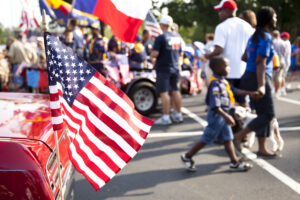Celebrate Safety This Parade Season!
 Guest post by Julie Jelen, LMCIT senior loss control consultant
Guest post by Julie Jelen, LMCIT senior loss control consultant
We’re in the peak parade and festival season, and parades can present distinctive safety challenges within our communities. Local safety managers should prioritize:
- Developing a written safety and emergency response plan
- Creating parade route maps
- Establishing speed limits or regulations for parade vehicles
- Maintaining a roster of performers or participants
- Devising a plan for efficient assembly, disassembly, and cleanup
Here are key elements to incorporate into parade safety plans:
Evaluate Regulations and Requirements
One of the first, and most critical, precautions is to evaluate local regulations and ordinances regarding parades. Make these requirements available to citizens in a centralized location. An online or physical “one stop shop” for city and county ordinances, permit applications, key contact information, volunteer or attendee policy, parking, and safety.
Compile Key Contact Information
It’s important to compile a master list of key personnel involved in the event. These contacts should encompass, but are not restricted to:
- City/county manager
- Police and fire chiefs
- Railroad officials (when crossing railroad tracks)
- Hospitals and emergency professionals.
Develop Emergency and Contingency Plans
This may be the most critical component of a safety plan. It is essential to inform event participants, organizers, and local safety teams about protocols for unexpected emergencies, including evacuation procedures and medical responses. It is a best practice to develop a contingency plan for adverse weather conditions or other potential disruptions. All parade organizers, participants, drivers, and pertinent public safety agencies involved in ensuring the event’s smooth operation should be briefed on the security and safety plan.
Provide Clear Route Maps
Route maps and emergency detour plans should clearly outline street closures for first responders and community members. Parade organizers need to carefully plan the parade route, especially around hospitals, schools, and jails. Additionally, performance zones along the parade route should be clearly designated and communicated to participants well in advance of the event.
Account for Physical Barriers and/or Security
Designated viewing areas enhance pedestrian traffic flow and help maintain order in emergencies. Safety managers must assess whether fencing is necessary for spectators standing along the streets and establish regulations for handheld signs or posters as needed.
Identify Participants
Parade organizers should identify all participants and performers, as well as the types of vehicles, uni/bicycles, large balloons, or animals that will be part of each display well in advance. Municipal officials should also assess whether chaperones are necessary for participants under a certain age. Furthermore, officials should consider regulations concerning alcohol consumption before and during the parade, restrictions on items like firearms and weapons, noise control measures, and guidelines for distributing items such as candy from floats to spectators.
Take Precautions for Animals
If animals are involved, officials should specify the species, number, and health status of each animal participating. Precautions must be implemented during parade line-ups to ensure the animals’ welfare and to prevent them from being startled by other participants or loud noises, which could pose a public safety risk. Additionally, parade organizers should plan for the proper removal of animal waste.
Confirm Driver and Vehicle Screening, and Insurance
Local law enforcement must verify that float drivers possess the necessary training and licensing to operate their vehicles during the event. It is standard practice to set speed limits and vehicle height restrictions tailored to the event, considering local infrastructure and any potential physical obstacles along the parade route. Insurance coverage for both vehicles and drivers should be confirmed, and municipal officials should assess whether additional insurance is required for the parade event.
Plan for Assembly, Disassembly, and Cleanup
Parade participants should be informed about designated loading, unloading, and parking zones for their vehicles. Residents and businesses near these zones or along the parade route should receive ample notification in advance. It is crucial for public health that trash and debris are promptly cleaned up according to a specified procedure, and that professional services handle the removal of rented sanitary units used during the event.
Additional Resources:
National Association of Counties (NACo)

